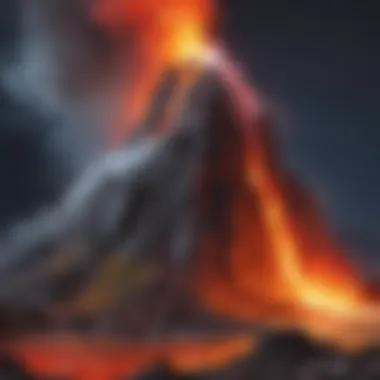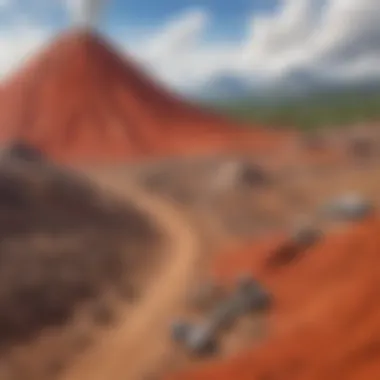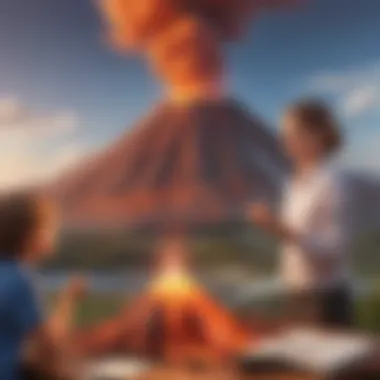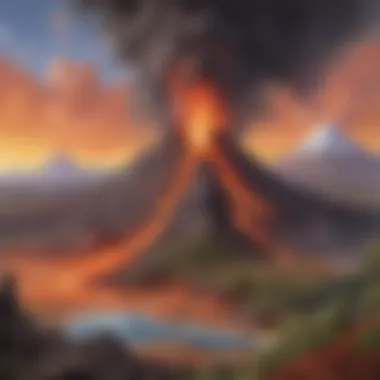Essential Materials and Steps to Create a Volcano Model


Intro
Creating a volcano model offers a unique blend of educational fun and scientific exploration. For young minds, this project ignites curiosity about geology and physical science. Not only does it capture attention, but it also encourages hands-on learning. In this guide, you will find everything necessary to construct a volcano, including essential materials, details of the eruption process, and related educational importance.
Science Fun Facts
Understanding volcanoes can be charming and enlightening. Here are some interesting facts about volcanoes:
- The largest volcano in the Solar System is Olympus Mons, located on Mars. It's about 13.6 miles tall—more than twice the height of Mount Everest.
- The word 'volcano' comes from Vulcan, the Roman god of fire.
- Lava from a volcanic eruption can reach temperatures of 2,200°F (1,200°C).
- There are over 1,500 active volcanoes worldwide. Some of the most famous ones include Mount St. Helens in the United States and Mount Fuji in Japan.
Now that these fun facts set a backdrop for our discussion, let’s delve deeper into the educational aspects of creating your very own volcano model.
Discover the Wonders of Science
Constructing a volcano not only reveals fascinating information about Earth’s processes; it also introduces various scientific concepts.
Exploring Various Scientific Concepts
Creating a volcano model helps young learners understand:
- The process of tectonic plate movements
- The cycle of magma formation
- Eruption mechanisms based on gas pressure
Educational Videos and Animations
Several online resources can assist and visualize these concepts, such as:
- BBC Bitesize: Offers simple animations demonstrating volcanic eruptions. (bbc.co.uk/bitesize)
- National Geographic: Features comprehensive videos on volcanoes. (nationalgeographic.com)
Interactive Learning Tools
Online simulations can aid comprehension. Tools such as PhET simulate the pressure buildup inside a volcano, showcasing how eruptions occur. Visit PhET.net for more.
Real-Life Applications of Science
Understanding volcanoes equips us with knowledge on natural disasters, environmental science, and geology, essential for various careers in science.
Science Experiment Showcase
Creating a volcano involves fun and engaging experiments. Here’s a simplified breakdown:
Fun and Engaging Experiments
Children will enjoy this experiment because it merges art and science into one compelling activity.
Step-by-Step Instructions
- Gather materials such as baking soda, vinegar, modeling clay, and a plastic bottle.
- Mold the clay around the bottle to form the volcano shape.
- Fill the bottle halfway with warm water and add a bit of red food coloring.
- When ready for the “eruption,” add two tablespoons of baking soda and pour in a cup of vinegar.
Materials List
- Baking soda
- Vinegar
- Modeling clay
- Food coloring
- A plastic bottle
- Warm water
Safety Tips and Precautions
Ensure the experiment is conducted in a suitable location with supervision. Avoid eye contact with vinegar and do not ingest any materials.
Creativity in learning is as vital as acquiring knowledge. Key experiences like these nurture a genuine appreciation for science.
Finally, each of these aspects contributes not just to knowledge about volcanoes, but also to developing a curiosity that drives future exploration within the realm of science.


Preamble to Volcanoes
Understanding volcanoes is crucial for grasping not just the natural world, but also the fundamental principles of geology and Earth sciences. Volcanoes represent powerful geological formations that have shaped landscapes and ecosystems throughout history. This relevance extends to educational environments where learners, especially elementary school children, can engage with basic concepts of earth science in an appealing way.
In this article, we delve into the intricacies of creating a volcano model, highlighting how this hands-on experiment can spark curiosity about natural phenomena. Exploring the components of what makes a volcano and examining the different types of these formations give students an opportunity to think critically about how geology impacts our world.
What is a Volcano?
A volcano is a rupture in the ground where molten lava, gases, and pyroclastic debris escape from below the Earth's crust. These openings can lead to the formation of beautiful structures we appreciate today, from small cones to enormous mountain ranges. Understanding this concept opens a pathway to exploring not only natural science but also theory behind geological processes like plate tectonics.
There are three main components that define a volcano:
- Magma Chamber: The reservoir where magma collects before an eruption.
- Conduit: This is the passage through which magma travels from the magma chamber to the surface.
- Crater or Vent: The opening at the earth's surface where the eruption occurs, allowing the materials to escape.
By grasping these basic elements, learners can better understand the volcanic activities that shape our planet over time.
Types of Volcanoes
There are several types of volcanoes, each distinctly characterized by their structure and eruption pattern. Understanding these types is essential in our quest to learn about volcanic nature and its types also illuminates their varying behaviors. The main types are:
- Shield Volcanoes: These have broad, gentle slopes created by the flow of low-viscosity lava that can travel long distances before solidifying.
- Stratovolcanoes (or Composite Volcanoes): These are known for their steep profiles and are built by alternating layers of lava flow, ash, and other volcanic debris, leading to explosive eruptions.
- Cinder Cone Volcanoes: These feature very steep slopes and are constructed from the smaller fragments of lava that fall back to the ground close to the vent. They are often the smallest type of volcano.
- Lava Domes: These are formed from slower-moving viscous lava, resulting in a dome-shaped mound over time.
Grasping the types of volcanoes allows students to format the dimensional scope of volcanic activity and enables a more nuanced comprehension necessary for employing standards in further lessons.
Volcanoes stand not only as wonders of the earth, but also as essential focuses for learning a foundations of science.
Basic Concepts of Volcanology
Understanding the basic concepts of volcanology is essential for grasping how and why volcanoes work the way they do. This knowledge allows one to appreciate the remarkable processes involved when a volcano erupts, creating an engaging learning experience for children and their educators. By having a foundational grasp of these principles, young learners can connect practical activities to scientific theories. This section highlights relevant mechanisms behind vas system and fundamental concepts surrounding volcanic activity.
Understanding Eruption Mechanisms
Eruptions are not random events; they occur due to specific volcanic mechanics. The core element governing these eruptions is magma, which originates from deeper structures within the Earth called magma chambers. As magma rises towards the surface, it carries gases dissolved within it. The way these gases interact with the magma primarily determines the type of eruption that will take place.
- Magma composition plays a critical role. Highly viscous magma, often rich in silica, leads to explosive eruptions. Conversely, magma with lower silica content tends to flow more freely, resulting in gentler lava flows.
- Eruption style can lead to different volcano behaviors: explosive, effusive, or a mixture of both. Understanding these interactions is not merely academic; it provides vital insight into hazards.
- Observing these eruptions also allows learners to visualize concepts such as pressure and gas expansions in real-time.
Recognizing these mechanisms can foster an understanding of safety when living in volcanic regions.
The Role of Pressure and Gas
Pressure and gases are the driving forces behind volcanic eruptions. When the pressure builds up within a volcanic system, it can dramatically affect the behavior of magma, leading eventually to an eruption.
- Gas Build-Up: Gases, like carbon dioxide or water vapor, are dissolved in the magma. As magma rises, the pressure reduces, allowing these gases to expand and form bubbles. This rapid expansion can lead to violent explosions.
- Pressure Triggers Eruption: If the pressure exceeds the strength of the surrounding rock, the magma will force its way to the surface, causing the eruption.
Remember the following points:
- Increased temperature can also cause expansion of the magma, further increasing the pressure.
- The type of eruption is influenced significantly by the rates of gas escape and pressure build-up.
Understanding these factors will not only elucidate how a volcano performs its spectacular acts but will also highlight critical safety considerations for the surrounding environment.
Knowledge of eruption mechanics allows young learners to engage with science at a deeper level, fostering critical thinking skills that will support their future exploration of geosciences.
Materials Required
Understanding the materials required for creating a volcano model is essential. The right materials can greatly influence the project's success and educational value. The aim is not just to create a visual aid, but to embrace the scientific principles that underlie volcanic activity. This section delves into common household items and construction components that are effective, safe, and suitable for young learners.
Common Household Items
Baking Soda
Baking soda plays a important role in the eruption process. It reacts when combined with an acidic substance, produing carbon dioxide gas. This gas creates the bubbling action mimicking a real volcanic eruption. Because of its safe and non-toxic nature, baking soda is a preferred item for this activity. It is easily accessible in nearly every kitchen, makng it a practical choice. The unique feature of baking soda is its alkalinity, providing a fun experience without any harmful elements.


Vinegar
Vinegar is another fundamental material for the volcanic eruption experiment. Its acidic nature enhances the reactions when used with baking soda. When combined, the two create fizzing and bubbling, simulating lava flow. Vinegar is readily obtainable and does not pose significant risks in controlled settings, which makes it a commonly used ingredient in science projects. The clear appearance of vinegar also allows for straightforward observation in the eruption process.
Food Coloring
Food coloring adds an artistic aspect to the volcano construction while aligning with its scientific purpose. It aids in creating a more visually appealing eruption, making the process engaging for spectators. Food coloring can easily be mixed into the vinegar to simulate lava. An attractive feature of food coloring is its wide variety of colors, allowing for customization of the project. It is also safe and simple to use, easily washing away afterward.
Constructing the Volcano Structure
Base Materials
Base materials are crucial for the stability of the volcano structure. Common choices include newspapers, cardboard, or plastic bottles which provide a strong foundation. These materials can be easily molded and shaped, forming the cone of the volcano. Their lightweight nature is beneficial, allowing for erect structures without excessive weight. However, care must be taken to ensure the structure remains intact during eruptions.
Mold Options
Selecting molds can simplify the construction process. Options include using plastic container, paper cups or even sculpting the base by hand. The right mold ensures uniform shape and height for the volcano. A unique feature of mold tools is their ability to create consistent shapes, often adding visual intrigue to the finished project. However, it is necessary to manage expectations as each mold can differ, influencing the final appearance.
Decoration Supplies
Decoration supplies enhance the appeal and provide a way to personalize your volcano. Materials like paint, moss, or clay mimic nature’s elements and add chatter to the volcano's aesthetics. These items allow young learners to express their creativity while educating them about volcanic features. Utilizing various texture and color enhances not just the visual aspect, but also sparks discussion about the geographic characteristics of real volcanoes. However, cautious supervision is necessary as some decorations could be small and pose a choking hazard to younger children.
Step-by-Step Guide to Creating Your Volcano
Creating a model volcano is not just a fun activity; it is an engaging way to learn about geological processes. By going through the steps, you can observe science in action. It helps reinforce concepts of the Earth's structure, eruptions, and reactions. This guide will take you through the specific elements required, the benefits of hands-on learning, and important considerations necessary for a successful volcano project.
Creating the Volcano Structure
To start, outline your volcano's structure clearly. This is the base and outline which gives your volcano its form. You will need materials such as plastic bottles or paper cups for the crater.
- Select a base option. You may use a sturdy cardboard base to support your volcano.
- Build the outer structure. Create the volcanic shape using clay or flour-based dough. Shape it over the bottle, which acts as the vent for your volcano.
- Decorate if desired. Use paints or markers to emulate natural materials like dirt or rock.
It is vital that your structure is stable. If it bends or falls, your eruptions will lack the impact. A well-constructed volcano captures the interest of everyone involved.
Preparing the Eruption Mixture
Once your volcano structure is designed, the next step is to achieve the mixture that will create the eruption effect. This is the chance to explore chemistry by combining several simple ingredients. Here is what you need:
- Baking soda: Provides the primary reaction when combined with vinegar.
- Vinegar: Creates the bubbling reaction through carbon dioxide gas release.
- Food coloring: For added visual effects and excitement, adding a few drops can create realistic lava color.
To prepare your mixture, follow these steps:
- Fill the bottle inside the volcano with about 1/4 cup of baking soda.
- Add a couple of tablespoons of dish soap. This helps in creating foamy lava, which looks more like real lava flows.
- Prepare another container with vinegar and food coloring mixed prior to your eruption.
Make sure proportions are not conflicting. Testing out the mixtures on smaller scales can be useful and gives you better control over your eruption.
Executing the Eruption
The eruption phase is where excitement builds. However, it needs solid planning to maximize the visual and educational aspects of the project. Here’s how to conduct the eruption effectively:
- Gather people around. This can be a school class or family members. Getting everyone engaged contributes to excitement.
- Pour in the mixture. First, pour vinegar mixed with food coloring into the bottle. This helps prepare the eruption moment.
- Add baking soda. Lastly, layer in more baking soda right after pouring the vinegar.
The output will be a bubbling and overflowing response, watching science at play.
“Demonstrating reactions visually enhances retention and sparks curiosity in scientific concepts.”
Make sure any surfaces used are covered to handle spills. Experiments can be messy, so plan for some cleanup afterwards.
Combining structure building, ingredient mixing, and executing the eruption turns a simple project into an informative session. Through each of these steps, a fundamental understanding of volcanology is cultivated, benefiting both children and adults accompanying them.


Safety Considerations
When engaging in a project to create a volcano model, safety considerations are crucial. Understanding how to manage the materials properly not only protects everyone involved but also enhances the learning experience. Addressing safety does not only focus on preventing accidents; it helps children grasp the importance of responsible behavior in science experiments. This aspect can lead to instilling good habits that last a lifetime.
Handling Materials Safely
When creating a volcano, selecting and managing materials safely is essential. Common materials like baking soda and vinegar are generally non-toxic but should still be handled with care. Here are some guidelines:
- Supervise children closely when they handle ingredients. This ensures that they understand what they are doing and helps avoid any accidental spills or misuse.
- Wear safety glasses to protect the eyes during eruption. Although this is often a playful activity, some participants may feel encouraged to experiment with larger quantities.
- Do not ingest any materials used in the eruption process, even if they are edible or safe in small quantities. Distinguishing between materials meant for experiments and those for consumption is important here.
- Clean up spills immediately to prevent slips or reactions with other unintentional combinations.
Educating children about why these safety measures are in place fosters respect for science and enhances responsibility.
Environmentally Friendly Practices
Implementing environmentally friendly practices is necessary as we create a volcano model. Minor adjustments can significantly impact the environment positively. Here are some points to consider:
- Use natural materials when possible. For example, acha-cave or sculpting materials can be made from sustainable resources.
- Dispose of items properly. Materials entered in the experiment should be discarded respectfully. Items like vinegar bottles and any other containers should be recycled where applicable.
- Choose biodegradable ingredients. For example, a fruity scent may come from essential oils, which break down easier than synthetic fragrances.
Maintaining an awareness of the environment is part of responsible citizenship in the science realm. Its habits formed now can lead to thoughtful decision-making in future science or crafting projects.
By reinforcing these safety considerations and environmentally friendly practices, children and educators can enjoy the volcano project while fostering thoughtful discussions about science and the environment alike. These habits will stick long after the final eruption has ended.
Extending Learning from the Project
Creating a volcano model goes beyond mere entertainment. It serves as a multifaceted educational tool that augments the understanding of earth sciences. Students engage actively with content, which is a key component of meaningful learning. This project connects practical experiences to theoretical knowledge, stimulating curiosity and providing tangible evidence of scientific concepts. Here, we delve into different elements and benefits of extending learning from this volcano project.
Discussing the Science Behind Volcanoes
To truly appreciate the art and science of making a volcano, it's pivotal to discuss the geology behind these natural phenomena. Volcanoes are not just spectacular events; they are part of a larger ecosystem influenced by tectonic plate movements. Explaining the earth's crust helps students relate their models to real-world processes. Here are some specific topics to consider when discussing the science of volcanoes:
- Plate Tectonics: Briefly describe tectonic plates and how their interactions lead to volcanic activity.
- Magma Formation: Explain how magma rises towards the surface due to changes in pressure and temperature.
- Eruption Mechanics: Discuss various volcanic eruptions and how gas build-up occurs beneath the surface.
The explenation enables students to connect their handmade volcanos to something much bigger happening in nature.
Engaging in Further Experiments
After building a volcano, the learning doesn't have to stop. Students can engage in various follow-up experiments that further solidify their understanding of the scientific concepts introduced earlier. Here is a list of experiments that can be conducted once the volcano project is complete:
- Experiment with Materials: Explore different substances to enhance or change the eruption. Mixing baking soda with lemon juice might yield different results than vinegar.
- Vary the Volcano Designs: Build multiple volcanoes with various heights or shapes and observe how the structure affects the eruption.
- Simulate Earthquakes: Use small shakes to simulate tectonic activities and how they might lead to eruptions.
Engaging in these further experiments allows students to apply their knowledge practically, deepening their grasp of fundamental scientific principles. Each step represents a chance to ask new questions and seek answers through inquiry and experimentation.
Maximizing the children's potential involves not just initial imipment of knowledge, but continuing development through hands-on experiments.
By ensuring a rich extension of learning beyond the volcano project, educators and parents facilitate an environment conducive to curiosity, inquiry, and actual understanding of our planet and its processes.
End
The importance of the conclusion in this article cannot be overstated. It summarizes the entire volcano project and emphasizes the benefits of engaging with such an educational activity. This segment ties together various aspects discussed in the preceding sections and highlights their relevance for elementary school children, parents, and educators alike.
Recap of the Volcano Project
Through this volcano project, young learners gain insights into not just how to build a physical model, but also the fundamental scientific principles that govern volcanic eruptions. Here’s a brief summary of what was covered:
- Understanding Volcanoes: The project introduced the basic definition of a volcano and looked at different types, enhancing comprehension.
- Required Materials: Various materials were outlined, focusing on common household items like baking soda, vinegar, and creative construction materials.
- Step-by-Step Instructions: A systematic guide led them through building the volcano, preparing the eruption mixture, and safely executing the eruption.
- Safety Best Practices: Importance of handling materials responsibly was stressed, ensuring a safe learning environment.
- Expanded Learning Opportunities: Encouraged consistency in scientific exploration, generating curiosity beyond the initial project.
This project not only delivers the aesthetics of a volcanic eruption but also embeds knowledge that kids can retain for future discussions.
Encouraging Future Exploration
As this project concludes, it opens the door to more explorations in science. Here are a few ways to inspire children further:
- Try Different Recipes for Eruptions: Use different quantities of baking soda or vinegar to observe changes in the reaction.
- Explore Geography: Relate volcanic modeling to real-world volcanoes. Discuss locations of active volcanoes globally.
- Experiment with Materials: Investigate how variations in materials affect the volcano structure or eruption outcome. Adding dish soap to the mixture, for instance, might yield different results.
- Create Interactive Presentations: Develop mini-reports or presentations based on the volcano and its functions. This improves communication skills and reinforces understanding.
Engaging young minds in scientific exploration not only enhances their knowledge but fuels a lifelong love of learning.
Encouraging questions and curiosity will help children develop critical thinking. Thus, further experiments spark joy in discovering new principles in science while making learning enjoyable. Overall, the volcano project can be the beginning of a continuous journey in understanding the science around us.







